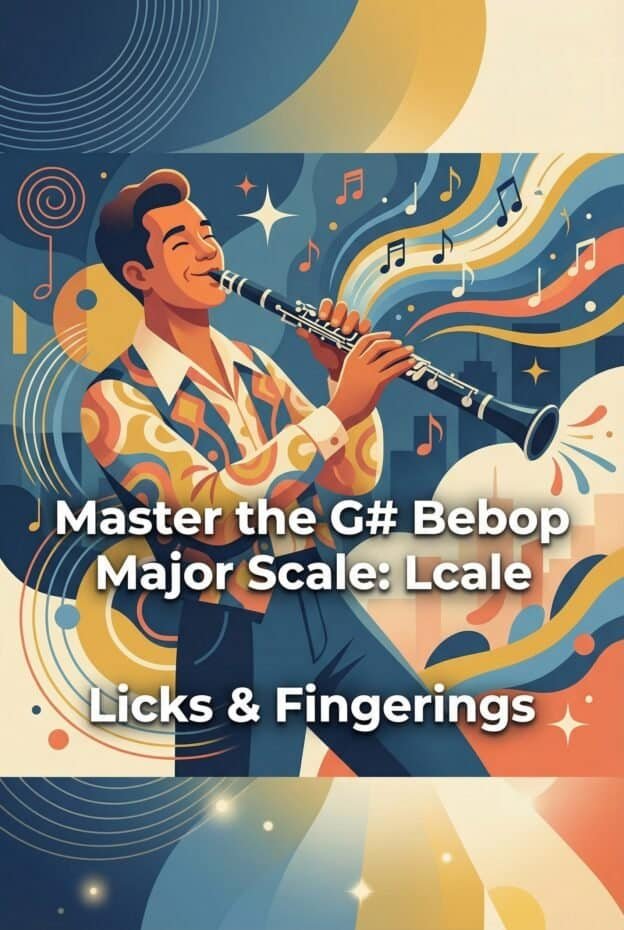The G# Bebop Major Scale (G#-A#-B#-C#-D#-E-F#-G#) is a major scale with an added chromatic passing tone used in bebop improvisation. On clarinet it provides smooth, chord-tone-focused lines in sharp keys. Use a dedicated fingering chart and step-by-step exercises to master clean finger motion, intonation, and fast bebop patterns.
About the G# Bebop Major Scale (notation and quick definition)
The G# Bebop Major Scale is an 8-note scale built from the G# major scale with one added chromatic passing tone between the 5th and 6th degrees. The notes are G#, A#, B#, C#, D#, E, F#, G#. The added tone, E natural, lets you land chord tones on strong beats in bebop lines.
Spelled in scale degrees, G# Bebop Major is: 1 (G#), 2 (A#), 3 (B#), 4 (C#), 5 (D#), chromatic passing tone (E), 6 (F#), 7 (G), and back to 1 (G#). Clarinetists often think of it as Ab Bebop Major, but the theoretical spelling in sharp form clarifies its function in sharp key harmony.
In jazz theory, this scale aligns with a G# major chord or Ab major chord in functional harmony. The passing tone fills the gap between the 5th (D#) and 6th (F#), so when you play straight eighth notes over a bar of G# major, chord tones naturally fall on downbeats, a core bebop sound.
Free Clarinet Fingering Chart (download + image description and file details)
This guide is paired with a free G# Bebop Major Scale clarinet fingering chart in printable PDF format. The chart shows standard Boehm-system fingerings for each note in the scale across chalumeau, clarion, and altissimo registers, plus suggested alternate fingerings for fast bebop passages in G# and Ab.
The PDF file is high-resolution, letter-size, and suitable for studio printing or tablet display. Each note in the G# Bebop Major Scale is labeled with concert pitch, written pitch for B-flat clarinet, and a clear fingering diagram. Side keys, pinky keys, and register key usage are highlighted for quick visual reference.
For classroom use, band directors can laminate the chart or project it during jazz sectionals. Private teachers can assign students to mark preferred alternates for particular licks. The file is accessible for free and licensed for personal and educational use, so students can keep a copy in their practice binder.
How to Finger G# on the Clarinet – Step-by-Step and Alternate Fingerings
G# causes confusion because clarinetists often think in Ab. On B-flat clarinet, written G# sounds concert F#. The basic chalumeau G#/Ab uses the same fingering as A-flat: left-hand first, second, and third fingers down, plus the left-hand G#/A-flat key operated by the left little finger.
Step by step in chalumeau: cover left-hand index, middle, and ring tone holes. Add right-hand index, middle, and ring fingers for low E. Then lift the right-hand ring finger and engage the left-hand G#/Ab pinky key. This produces written G#/Ab below the staff with a stable, dark tone when the instrument is sealed correctly.
In the clarion register, written G# above the staff is fingered like clarion A-flat: left-hand first, second, and third fingers, register key, and the same left-hand G#/Ab pinky key. This fingering can feel awkward in fast passages that alternate with A or F, so many players experiment with alternate pinky combinations to reduce motion.
For altissimo G#/Ab, fingerings vary by instrument and setup. A common option is: left-hand first and second fingers, register key, right-hand first and second fingers, and the right-hand G#/Ab pinky key. Some clarinetists add the right-hand F/C key for stability. Use a tuner to choose the best option for your clarinet.
Alternate fingerings are important in bebop tempos. For example, in a rapid G#-A#-B# run, you can use the right-hand G#/Ab pinky instead of the left to avoid crossing under the hand. Similarly, in descending lines that include F#-E-D#, try alternates that minimize pinky switches between the G#/Ab key and the low F/E keys.
When you practice G# fingerings, isolate transitions such as F# to G#, G# to A#, and D# to E to F#. Work them at slow tempos with a metronome, keeping fingers close to the keys. Aim for identical hand shape in both G# and neighboring notes so that the change feels like a small key motion instead of a full hand reset.
Practice Exercises and Bebop Licks Using the G# Scale
Start with simple one-octave G# Bebop Major scales in eighth notes. Ascend and descend from low G# to the next G#, keeping the E passing tone between D# and F#. Use a metronome at quarter note = 60 and increase by 4 bpm when you can play 4 clean repetitions without missed notes or intonation drift.
A useful pattern is the classic bebop enclosure: A#-G#-B#-A# over a G# major chord. Insert the E passing tone to connect chord tones: G#-A#-B#-C#-D#-E-F#-G#. Then create four-note cells like B#-C#-D#-E and sequence them starting on each scale degree. This builds familiarity with the chromatic passing tone in musical context.
Try a basic lick: G#-A#-B#-C#-D#-E-F#-G#-F#-E-D#-C#-B#-A#. Play it in straight eighth notes, then swing eighths. Once it feels comfortable, displace the starting point: begin on B# or D# but still use the full bebop scale. This teaches you to hear the scale over different chord tones, a key bebop improvisation skill.
For clarinet agility, write out arpeggio-based patterns such as G#-B#-D#-F# using only notes from the bebop scale. Insert E as a neighbor tone between D# and F#. For example: G#-B#-D#-E-F#-D#-B#-G#. Practice this in both chalumeau and clarion registers, keeping finger motion minimal and even.
Another effective drill is alternating between G# Bebop Major and its relative minor scale patterns. Move from G# Bebop Major to F minor or F# minor patterns, then back, without stopping the metronome. This simulates real improvisation where you pivot between related tonal centers while maintaining smooth chromatic motion.
Record yourself playing 2-chorus solos over a simple G# blues or Ab rhythm-changes backing track, using the G# Bebop Major Scale as your main vocabulary. Listen back for spots where G# fingerings feel clumsy or intonation drifts on E or D#. Use those moments to design focused, short technical exercises.
Bebop History: Clarinet, G# Scale Examples, and Archive References
Bebop emerged in the early 1940s in New York, with players like Charlie Parker and Dizzy Gillespie documented in DownBeat magazine and Library of Congress recordings. Clarinet took a smaller role than saxophone, but artists such as Buddy DeFranco and Tony Scott adapted bebop language, including bebop major scales, to the clarinet.
While few charts explicitly label a G# Bebop Major Scale, the sound appears in sharp-key passages. Buddy DeFranco's recordings from the late 1940s, preserved in Smithsonian jazz archives, show rapid lines in keys like Ab and B that outline major chords with chromatic passing tones between the 5th and 6th degrees, the hallmark of bebop major usage.
Benny Goodman and Woody Herman, associated more with swing, gradually incorporated bebop vocabulary. On later live broadcasts from the late 1940s and early 1950s, transcriptions reveal clarinet lines in Ab major that use continuous eighth-note patterns with chromatic connectors, functionally identical to the bebop major approach even if not labeled that way at the time.
DownBeat reviews from the mid-1940s describe bebop improvisers as using “long, running scales with passing tones” to outline complex harmonies. Modern jazz pedagogy, drawing on these historical practices, formalized the term “bebop major scale” to describe the 8-note structure used to keep chord tones on strong beats, including in sharp keys like G# and Ab.
For archivists and students, comparing early swing clarinet solos in Ab with later bebop-influenced recordings highlights the shift. Earlier solos favor diatonic Ab major with occasional chromatic approach tones, while bebop-era lines show more systematic use of an 8-note major scale pattern that matches the G#/Ab Bebop Major concept.
Instrument Anatomy: Why G# Feels Different on the Clarinet
G# feels awkward on clarinet because it relies on a side key operated by the little finger instead of a main tone hole under a primary finger. The G#/Ab key is part of a complex lever system that also connects to the A#/Bb and low F/E keys, so small mechanical issues or extra motion can disrupt smooth action in fast bebop lines.
In the chalumeau register, the G#/Ab key opens a small tone hole near the top joint. Its placement and size affect both pitch and response. Because the key is off to the side, the little finger must move laterally, which can cause tension or uneven timing compared to the straight up-down motion of the main fingers.
In the clarion register, the register key changes the effective length of the air column, and the same G#/Ab mechanism now produces a different harmonic. The interaction between the register vent and the G#/Ab tone hole can make clarion G# slightly unstable or sharp on some instruments, especially if the pad height or spring tension is not well regulated.
Alternate G# fingerings often use half-holes or different side keys to adjust the acoustic length of the tube. For example, some altissimo G#/Ab options involve partially venting a side key or combining several keys to fine-tune pitch. These fingerings change which tone holes are open, altering impedance peaks and helping stabilize difficult notes.
Because the G#/Ab key is linked through long rods, any slight bend or misalignment can affect how cleanly the pad seals. This is why G# often reveals mechanical problems first. If your G# feels resistant or inconsistent while other notes are fine, the underlying cause is frequently in the G#/Ab key mechanism or its related levers.
Technical Challenges, Intonation Tips, and Troubleshooting
Common G# problems include squeaks when slurring to or from B#/C#, unstable pitch in the clarion register, and sluggish pinky motion in bebop tempos. Start troubleshooting by checking your finger height. If fingers lift too far from the keys, coordinating the G#/Ab pinky with the rest of the hand becomes much harder at fast speeds.
For intonation, many clarinets play clarion G# slightly sharp. Counter this by slightly relaxing the embouchure, adding a bit more mouthpiece cushion on the lower lip, and thinking of directing the air slightly lower in the oral cavity. Use a tuner to map your G# tendencies in both chalumeau and clarion registers at soft, medium, and loud dynamics.
If G# squeaks when approaching from B#/C#, check that your left-hand first finger remains firmly sealed. Tiny leaks at that tone hole become more obvious when the G#/Ab key opens. Also confirm that your reed is not too hard or too soft; both extremes make the delicate transition around the E passing tone and G# more unstable.
When chromatic passages using the E passing tone feel uneven, isolate the three-note groups D#-E-F# and F#-G#-A#. Practice them slowly with a tuner, then gradually speed up. If one note consistently pops or sags, experiment with very small embouchure adjustments and alternate fingerings to find a smoother response.
Mechanical issues can also cause trouble. If G# speaks late or feels stuffy while neighboring notes are clear, gently test the G#/Ab key by pressing it while shining a light inside the bore. Look for uneven pad contact. If you see light leaking around the pad or feel key wobble, it is time for a professional adjustment.
Maintenance Steps That Improve G# Response (reeds, pads, regulation)
Good G# response starts with a balanced reed. For bebop work in G#, many clarinetists choose a medium-strength reed that allows quick articulation without biting. Test reeds by playing long tones on G# in both chalumeau and clarion. If one side of the reed feels resistant, very light balancing can improve clarity on sensitive notes like G#.
Ligature placement also affects G# stability. Position the ligature so it holds the reed securely without pinching. If the reed can shift during fast passages, you may notice sudden changes in G# response. Mark your preferred ligature position on the mouthpiece cork with a tiny pencil dot to keep setup consistent between practice sessions.
Pad condition is critical on the G#/Ab key. Check the pad for deep grooves, discoloration, or hardening. A compromised pad may still seal enough for slow playing but fail under the increased air pressure of loud bebop lines. Have a technician replace worn pads and check that the G#/Ab key closes with even pressure across the tone hole.
Key regulation ensures that related keys close and open together. On many clarinets, the G#/Ab key is linked to the A#/Bb and low F/E keys through shared rods and adjustment screws. If one screw backs out or a cork bumper compresses, the timing between keys can shift, causing leaks on G# even when the key appears to move normally.
Regular tenon cork care also helps. If the upper joint becomes loose, small misalignments between tone holes and keywork can change how the G#/Ab pad seats. Apply a small amount of cork grease as needed, and avoid forcing the joints together. If the fit becomes too loose or too tight, have the corks refit by a technician.
Famous Recordings, Scores, and Where to Hear the G# Bebop Major Scale
While charts rarely label a passage as “G# Bebop Major,” you can hear its sound in many bebop and post-bop recordings where clarinet or saxophone solos move through Ab major with chromatic passing tones. Buddy DeFranco's small-group recordings from the late 1940s and early 1950s are prime listening for clarinetists studying bebop major usage.
Transcriptions of Tony Scott solos also reveal extended lines in sharp keys that use an 8-note major scale approach. Listen for phrases where chord tones land on strong beats while chromatic notes, including the equivalent of the E passing tone in G#/Ab, fall on upbeats. This rhythmic placement is the functional hallmark of the bebop major scale.
Big band scores from Woody Herman's later bands and arrangements recorded by Benny Goodman in the post-war era sometimes feature saxophone and clarinet section lines in Ab that outline major chords with passing tones. Even if the parts are not explicitly annotated as bebop scales, the melodic structure closely matches G#/Ab Bebop Major practice.
For modern examples, many jazz education recordings and play-along tracks demonstrate bebop major scales in all keys. When you hear a demonstration of Ab Bebop Major, remember that the same pitch collection, spelled differently, corresponds to G# Bebop Major. Listening and playing along will help you internalize the sound and finger patterns.
Use notation software or a transcription app to slow down solos and identify moments where the soloist runs straight eighth notes over a major chord with a chromatic passing tone between the 5th and 6th. Mark these passages in your part and practice them on clarinet, paying special attention to G#/Ab fingerings and the E passing tone.
Modern Applications and Player Outcomes (what you will gain practicing this scale)
Practicing the G# Bebop Major Scale on clarinet builds fluency in one of the more challenging key areas for the instrument. You gain stronger pinky coordination, better control of side keys, and more reliable intonation on G#/Ab and E, which often reveal mechanical or embouchure weaknesses in intermediate and advanced players.
From a jazz perspective, mastering this scale gives you a ready vocabulary for improvising over tunes in Ab major and related harmonic contexts. You will be able to create long, flowing lines where chord tones fall naturally on strong beats, a core aspect of bebop phrasing that translates to all keys once internalized.
Set measurable goals for your practice. For example, aim to play two octaves of G# Bebop Major in eighth notes at quarter note = 120 with no finger fumbles, then gradually increase to 144 or 160. Track your progress over 2 to 8 weeks, noting improvements in speed, tone, and comfort with alternate G# fingerings.
Teachers can use the G# Bebop Major Scale as a diagnostic tool. Students who struggle with G# often need work on hand position, pinky independence, or reed setup. By focusing on this scale, you can address those technical issues while also teaching bebop theory and ear training in a concrete, applied way.
Over time, consistent work with the G# Bebop Major Scale improves overall clarinet agility. The same skills that let you navigate G# bebop lines cleanly will help in orchestral excerpts, contemporary chamber music, and any repertoire that demands secure side-key technique and accurate intonation in sharp keys.
Resources, Downloads, and FAQ
Use the free G# Bebop Major clarinet fingering chart as your daily reference. Keep it on your stand while practicing scales, arpeggios, and licks. Combine it with recordings of bebop clarinetists and modern play-along tracks so that theory, fingerings, and sound are always linked in your practice routine.
Band directors can integrate the chart into jazz sectionals by assigning each student a short G# bebop lick to learn and transpose. Private teachers can pair the chart with weekly metronome goals and recording assignments. Archivists and historians may find it useful when analyzing sharp-key passages in early bebop clarinet solos.
Key Takeaways
- The G# Bebop Major Scale is G#, A#, B#, C#, D#, E, F#, G#, with E as the chromatic passing tone between 5 and 6.
- Clarinet G#/Ab relies on side keys and pinky coordination, so alternate fingerings and careful maintenance are important for clean bebop lines.
- Focused practice in G# improves finger agility, intonation, and bebop phrasing in sharp keys, with measurable gains over 2 to 8 weeks.
FAQ
What is G# Bebop Major Scale?
The G# Bebop Major Scale is an 8-note version of the G# major scale that adds a chromatic passing tone between the 5th and 6th degrees. Its notes are G#, A#, B#, C#, D#, E, F#, G#. Jazz musicians use it to keep chord tones on strong beats in continuous eighth-note lines.
How do I finger G# on the clarinet?
In the chalumeau register, finger G# like Ab: left-hand first, second, and third fingers down, plus the left-hand G#/Ab pinky key. In the clarion register, add the register key to the same basic fingering. For altissimo, use a recommended alternate fingering and check pitch with a tuner, since options vary by instrument.
Is G# the same as Ab on the clarinet and does fingering change?
On B-flat clarinet, G# and Ab are enharmonic equivalents, so they use the same fingerings. The difference is in notation and harmonic context, not in how you press the keys. You may choose different alternate fingerings depending on the surrounding notes, but the basic G#/Ab fingering is identical.
Where can I download the free G# Bebop Major fingering chart?
You can download the free G# Bebop Major clarinet fingering chart as a printable PDF from the Martin Freres educational resources section. The file includes standard and alternate fingerings for all notes in the scale across three registers, optimized for bebop practice and classroom use.
What practice exercises help build speed and accuracy for bebop lines in G#?
Practice one- and two-octave G# Bebop Major scales in eighth notes with a metronome, then add four-note patterns and enclosure licks using the E passing tone. Work isolated groups like D#-E-F# and F#-G#-A# for finger clarity. Gradually increase tempo, aiming for at least quarter note = 144 with clean, even tone.
Why does my G# squeak or sound out of tune and how do I fix it?
Squeaks or intonation issues on G# often come from leaks in the G#/Ab key, unbalanced reeds, or tense finger motion. Check pad sealing, test different reeds, and keep fingers close to the keys. Use a tuner to map your pitch tendencies and adjust embouchure and air support. Persistent problems may require a technician's adjustment.
Which famous recordings feature the G# Bebop Major Scale or similar bebop lines?
Recordings by Buddy DeFranco and Tony Scott in the late 1940s and 1950s feature clarinet solos in sharp keys that use bebop major-style lines, including the equivalent of G#/Ab Bebop Major. Later big band recordings by Woody Herman and Benny Goodman also include section and solo passages in Ab that reflect the same 8-note major scale approach.







